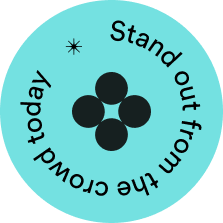
Social Media Content
Social media offers great potential to build strong relationships and drive awareness of your brand, but to make the most of it you must have high-quality content.
Why use social media content?
Social media is one of the most powerful content marketing tools available to any business.
Billions of people all over the world use the likes of Facebook, Twitter, Instagram, YouTube and TikTok every day. The right social media strategy will get your brand and its messages seen by an enormous audience. If even a small portion of the people who discover your social content become leads and eventually customers, the benefits for your business will be huge.
Of course, there’s intense competition between brands to capture the attention of internet users. To succeed in this fast-moving and increasingly demanding space, you need a rock-solid social media content strategy.



What types of social media content should businesses create?
This is a vital question to ask as you take your first steps in planning your social media marketing activities. There are many different types of content you can post to your social channels, so it’s worth taking the time to consider which ones will generate the best results for you.
Video
Video is a hugely powerful and endlessly versatile medium for marketing. Whatever line of business you’re in, you’ll be able to use video in some way, and there’s a good chance you’ll see an excellent return on your investment.
This is a particularly useful type of content for social media, because it can help you achieve the instant impact and strong engagement that’s required to make a lasting impression on your target audience in a hectic environment.
There are countless ways you can use video in your social media marketing, from posting live video updates about a forthcoming product launch to giving people a glimpse behind the scenes of your business.
Blog posts and articles
Blog posts and written articles have a key role to play in your broader content marketing strategy. They can help with:
- Attracting more visitors to your website through SEO
- Providing value to your target audience by addressing their most common problems and questions
- Demonstrating your knowledge and understanding of a particular subject

When you need to promote this content, social media is one of the best places to do it. Sharing headlines, statistics and enticing snippets from articles is a good way to capture people’s interest and encourage them to click through and read the whole piece.
GIFs and animations
Much like video, GIFs and animations are well-suited to the frenetic and fast-moving world of social platforms. What’s more, they’re a great way to inject some life and fun into your social media content marketing, which can be particularly useful if the product or service you’re promoting is somewhat dry or complicated.
Rather than writing a long blog post containing all the details of how your latest piece of software works, for example, you could create an animation that shows it in action and demonstrates how users stand to benefit from its key features.
Eye-catching imagery
Social media is a heavily visual space, where user decisions on what to look at and what to ignore are often driven by images. Your success in this area could depend on how well you use imagery, particularly when you’re working to build your brand identity or increase recognition of a specific product.
Coming up with creative and unusual ways to present product photos, for example, could really help your products stand out and make an impact on potential customers. This could prove particularly beneficial on Instagram, where users are accustomed to seeing slick and expertly designed marketing materials.

User-generated content
There are many advantages to incorporating user-generated content into your social media marketing. For example:
- It can add authenticity to your brand, with research showing consumers are 2.4 times more likely to view this content as authentic, compared to assets created by companies
- It fosters trust and helps customers feel confident that you’re able to deliver for your audience
- It uses the power of your customer base to expand and diversify your marketing mix
Engage with your audience on social media to identify possible opportunities to distribute user-generated content across your social platforms. Just be sure to get the owner’s permission before including anything they have produced in your marketing.
Infographics
Infographics are another visually engaging content type that can make a powerful impact across your social channels. When you have a large amount of dense or data-heavy information you need to convey to your audience, an infographic can present it in a clear and easily digestible way.
If you have recently conducted some research on key themes in your industry, for example, you could use an infographic to present the most significant findings and illustrate trends.
Furthermore, this content type is highly shareable, making it ideally suited to social media.
Industry news and commentary
If you’re a B2B brand, you can gain a lot of credibility and showcase your knowledge to clients by discussing the latest goings-on in your industry on social media.
As well as demonstrating your insights and providing some value to your customers, this approach shows that you’re not only interested in talking about yourself and promoting your own products.
Twitter is a good platform for sharing headlines and pointing users towards sources of more information, while LinkedIn is often the first choice of professionals looking to network and learn more about their industry.

Customer reviews and testimonials
Positive reviews and testimonials from customers are a powerful marketing tool, so you should do everything you can to leverage and promote them on social media.
Pick out some of your happiest and most loyal customers and ask if they would be willing to provide a short review or testimonial for you to share in your social media marketing. Or, you could find positive feedback you have received in the past and ask for that customer’s permission to post it on your social channels.
This is one of the best ways to show prospective customers that you can deliver on the promises made in your marketing.
How to develop and manage your social media content
The seemingly endless variety of content you can produce and promote on social media provides great opportunities, but it can also present a challenge.
How do you know where to start when it comes to developing your social media content, and how can you ensure your social media management is up to scratch?

Social media is the ideal environment to make connections with your target audience, start conversations and identify their biggest priorities, pain points, questions and concerns.
There are various ways to go about this. One strategy that can deliver results is to focus on humanising your brand and giving people an insight into the personal side of your business. You can work towards this goal through your content – by producing videos featuring members of your workforce and posting articles written by company leaders, for example.
If your customers feel they can engage with your company on a human level, you can start to have productive conversations that will inform your social media content planning and development.
Social listening enables you to track mentions of your brand and keep your finger on the pulse of social media conversations that are relevant to you. You can use it for anything from monitoring what customers are saying about you on social channels to evaluating demand for particular products or services in your sector.
If a Twitter user shares a positive tweet about one of your products, for example, social listening will alert you to it so you can respond to them and say thank you. As well as strengthening your relationship with this particular customer, this engagement will reflect positively on your brand and help you attract new buyers.
Social listening can prove just as important when you receive negative feedback or complaints online and you need to tweak your content strategy accordingly.
Social media content production needs to be carefully planned and structured. This is essential to ensure your content is evenly distributed across your channels and you’re posting regularly enough to maintain engagement with your audience.
The best way to manage this and have complete visibility over what is going live, on which channels and at what times, is with a social media content calendar.
A well-planned calendar will unlock all sorts of benefits for your business, including more efficient use of your social media marketing team’s time and confidence that you won’t forget to share content relating to special events or occasions that are relevant to you and your audience.
There are many tools out there that can help you plan and manage your social media content with greater efficiency.
Among the most popular and effective are:
- Buffer
- Semrush
- Hootsuite
- HubSpot
- Sprout Social
These platforms – some of which offer limited functionality for free – make it much easier to optimise your social media management. You can use them for anything from basic tasks like scheduling a social media post to go live at a particular time, to more advanced activities such as analysing your content and the levels of engagement it’s receiving.
Like every other element of your marketing, social media content will deliver the best results when it’s backed up by effective data collection and analytics.
You should be regularly gathering information on vital metrics such as:
- Shares
- Likes
- Net new followers on specific social channels over a given reporting period
- Brand mentions (which can be made more relevant through comparison to competitors)
Analysing this data and keeping an eye on how it changes over time will give you crucial insights into the success of your social media marketing. It will help you understand everything from how well you’re building brand awareness and engagement, to levels of satisfaction and loyalty among your existing customer base.

Challenges of creating effective social media content
You should always be prepared to make the most of new opportunities and potential for growth on social media, but it’s also important to educate yourself on the most common challenges in this space and prepare for them.

Selecting the right platforms
As tempting as it might be to distribute an array of content across multiple social media platforms in the hope of building the largest possible following, you’re more likely to get results from a more targeted approach.
That means identifying and focusing your efforts on the channels that are best-suited to your brand, the sort of content you produce and the interests and browsing habits of your target audience.
The most useful guide to where you should be dedicating your time and attention is your audience itself. As part of your customer research and buyer persona creation, look into where your ideal clients spend their time online, which networks they favour and what content types will prove most engaging and valuable for them. This will be crucial in helping you decide which social media channel, or channels, to prioritize.
Defining specific goals
You need to set clear goals before embarking on a social media campaign. Without them, you won’t know what outcomes you’re aiming for and whether all the time and budget you’re investing in these activities is paying off.
There’s a good chance you’re interested in overarching objectives such as increasing brand awareness, generating more leads, strengthening community engagement and attracting more traffic to your website. But do you have a clear, data-driven plan for how you will benchmark your progress towards these aims, and the metrics and key performance indicators you will use along the way?
One good practice is to use SMART goals, which should be:
- Specific
- Measurable
- Achievable
- Relevant
- Time-bound
This framework helps to add specificity to your target setting and reduces the risk of you wasting time and effort on pursuing goals that don’t make sense for your business.

Measuring ROI
Having clear and measurable goals is crucial to another key aspect of your social media marketing: evaluating the return on investment (ROI) you’re seeing from each piece of content you produce.
This can be particularly difficult with certain types of social media content, compared to other elements of your marketing. The value of shares or likes generated by a post on Facebook, for example, is harder to gauge than that of clicks on a display advert.
It’s for this reason that you need to start every social media marketing campaign with a clear picture of what constitutes success, so you know when you’re falling short and you need to change your approach.

Underperformance
It can be disheartening to see a piece of social media content or an entire campaign underperform after you have dedicated a lot of time, effort and investment to it.
The most beneficial thing you can do in this scenario is to investigate the reasons why your content isn’t delivering the results you were hoping for. A specialist social media management tool will help you track the levels of engagement and positive results you’re gaining from particular social posts and content.
You can then look for trends and themes in the assets that are delivering positive outcomes, compared to those that are underperforming. It’s also crucial not to hesitate to make changes and try new methods when it’s clear that certain tactics aren’t generating good results.
Standing out
Arguably the biggest challenge of all where social media content is concerned is producing something that helps your brand stand out from the crowd. This is an extremely congested and competitive segment of the digital marketing sector, and it’s becoming increasingly difficult for individual brands to get noticed, especially if you’re not yet a well-known name in your industry.
If you’re facing this challenge, here are some positive practices that could help you overcome it:
- Make sure you understand your audience and focus your efforts on connecting with them. You can’t market to everyone all the time.
- Create and share dynamic and visually engaging content, such as videos, infographics and custom images.
- Ask how you can build meaningful and lasting relationships with your audience, through tactics such as responding to questions quickly and showing customers that you value their feedback by acting on it.

Social media content ideas
Whatever stage your business is at in its journey, and whatever goals you’re hoping to achieve in your marketing, making the right choices with your social media content will be crucial if you’re to succeed.
Here are a few great ideas that could help give your social media marketing the boost it needs to stand out and deliver results.
If you’re a new business and you want to make a big impression on Facebook, Twitter and the like, one way to do it is with a contest or giveaway that gives something back to your followers.
You could increase engagement by setting certain conditions to be in with a chance of winning, such as following your account on Instagram or signing up to your newsletter.
What’s more, you can promote your latest products or services in the prizes you choose to give away.
When you’re preparing for a product launch, don’t miss the opportunity to promote it by creating and distributing eye-catching visual content across your social media channels.
There are many ways to approach this, but one tactic that can be highly effective is to be creative and think about how you can showcase your product in a way no other company has before. This could involve anything from placing it against an unusual backdrop to showing it being used in a way that might not occur to your audience.
Your social media content should consist of more than your own insights and creations. When you come across a news article, an opinion piece or a study that you find particularly useful, for instance, share it on your social channels to pass on the value to your audience.
This shows that you have your finger on the pulse of your sector and also that you’re not only interested in talking about yourself on social media.
Adding an element of humanity to your brand and making genuine connections with customers has never been more important in the highly competitive world of social media marketing.
One good way to do this is with video, which is a powerful content format for making a positive impact on your audience and leaving them with a lasting impression.
A ‘day in the life’ video that introduces some of your key members of staff and gives people a glimpse of the inner workings of your company, for example, could be particularly effective when you want to show the personal side of your business.
If a large portion of your target audience is facing a common challenge – responding to a recent change in industry regulations or a sudden spell of unseasonable weather, for example – you can help them out by producing a guide or tutorial recommending solutions to this problem.
While your website will be the best place to host these sorts of assets, your social media content will have a crucial role to play in discussing the key issues, promoting your guides and directing people to them.

To really make the most of the assets you’re producing and distributing across your social channels, it’s a good idea to get expert support and advice.
Working with a specialist content agency will help you get maximum value from your budget and measure your performance across all channels.